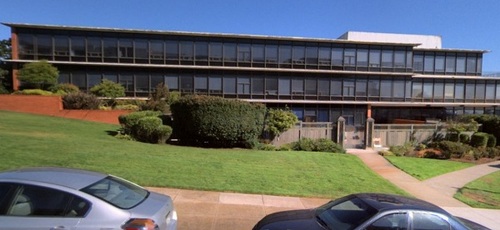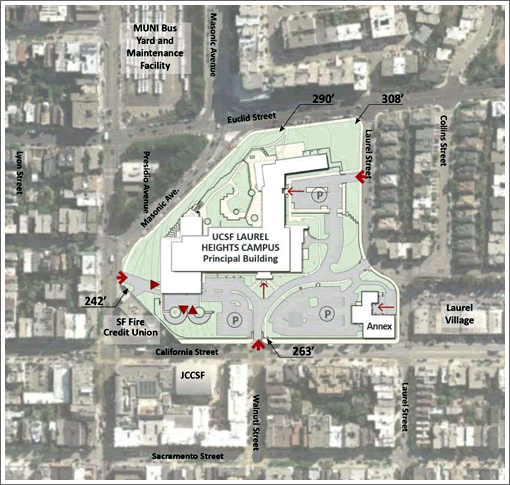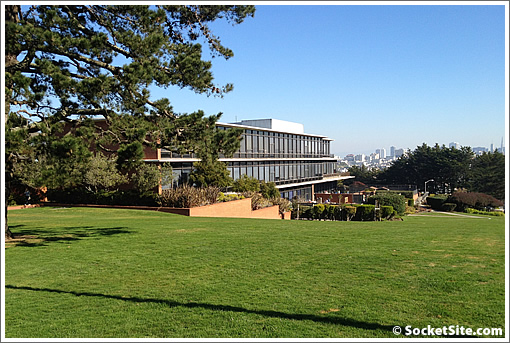
UCSF Laurel Heights Site, 3333 California St. (Planning, Design or Conception) – San Francisco – 94118
UCSF Laurel Heights Site, 3333 California St. (Planning, Design or Conception) – San Francisco – 94118
UCSF’s Chancellor’s Executive Cabinet has approved the issuance of a Request for Proposals (RFP) to redevelop UCSF’s 10-acre Laurel Heights campus at 3333 California Street, seeking to realize “the highest and best use of the site [and] maximize the value of the property.” UCSF will be exploring options for relocating its 1,200 Laurel Heights employees to other campuses in San Francisco over the next couple of years.
Local Map
The Laurel Heights campus which was first developed by the Fireman’s Fund Insurance Company in 1955 and acquired by UCSF in 1985 encompasses an oversized city block, with fronts on California, Presidio, Masonic, Euclid, and Laurel Streets.
The campus site with a current 40-foot height limit is located in an RM-1 residential zone which permits approximately one dwelling unit per 800 square feet of land or one dwelling unit per 600 square feet of land if approved as a Planned Unit Development. There are 43,560 square feet per acre. The property could also be used for offices, which is the existing legal non-conforming use.
Proposals are tentatively scheduled to be due in May with a developer and plan set to be selected in June. The selected developer “will be capable of achieving entitlement approvals from the City as early as possible” with an expected time horizon of 4 to 10 years to complete the development.
UCSF has put out a request for qualifications for developers to transform its Laurel Heights campus. The 10.3 acre property contains a 447,000 sq.ft. of building space, and is currently zoned for residential development with a 40-foot height limit. UCSF is open to sale of the property or a ground lease agreement, and is floating the idea of reusing the property as offices or knocking it down to make way for condominiums, rental apartments, or senior housing. Zoning could allow 550-700 units. Or maybe they’ll just turn it back into a cemetery? The move is seen as part of UCSF’s shift toward Mission Bay, with their new $1.6 billion hospital set to open in late 2014. The university is expected to come up with a short list of qualified developers by February 21.
The University of California, San Francisco is looking to hand off its Laurel Heights campus to a developer, even as it seeks a 300,000-square-foot Mission Bay expansion.
UCSF has issued a request for qualifications for a developer to take on the 3333 California St. campus, a 10.3 acre property which consists of 447,000 square feet of building space — a 350,000-square-foot main building, a 13,000-square-foot annex, and 543 parking spaces split between surface lots and an underground garage.
UCSF has held the property since 1985. Across the street from the Jewish Community Center, it is zoned for residential development and has a 40-foot height limit. The property could continue to be used as offices or knocked down to make way for condominiums, rental apartments or senior housing, according to UCSF. A deal with a developer could be either a sale of the property or a ground lease arrangement.
The zoning allows one dwelling units per 800 square feet of land, which translates to about 550 housing units. If the project were to be approved as a “planned unit development” under the San Francisco planning code, the number of allowable units would jump to 700.
Development groups looking at the Laurel Heights site include housing developers such as Prado Group, OliverMcMillan, Wilson Meany, SKS Development, Sares Regis Group of Northern California, TMG Partners, Tishman Speyer and Wood Partners. Sares Regis and TMG Partners are responding as a partnership, as are SKS and Prado Group.
District 2 Supervisor Mark Farrell said he is working with UCSF and surrounding neighborhood groups to “ensure that we don’t have a situation where the size and scope of the current buildings are massively increased.”
“The campus is a large campus and it’s right smack in the middle of a number of neighborhoods,” said Farrell. “If done wrong, it could potentially have a negative impact.”
The move is part of UCSF’s continuing shift toward Mission Bay. This has been going on for years, but is accelerating as the university sets to open its new $1.6 billion hospital in late 2014.
The Mission Bay project will likely come down to the handful of developers who have sites or existing buildings within close proximity to the new hospital.
Mission Bay Development Group, the master developer for the neighborhood, is hoping to lure UCSF to Block 40, a triangle-shaped parcel at 701 16th St., which is zoned for 700,000 square feet of office or biotech. The company has hired Perkins + Will to design the project and is also talking to other users. The site had been on the market in 2011, but was pulled. “We are in conversation with a couple of different tenants so we have the potential to build it ourselves,” said Seth Hamalian, a partner with the firm.
Salesforce has reportedly given a handful of developers the green light to respond to the RFP on its behalf. Salesforce owns 12 acres of Mission Bay property that is entitled for 2 million square feet. The cloud computing company originally planned to develop the project, but earlier this year shifted gears and decided instead to expand in the south financial district at 50 Fremont St., 350 Mission St. and the Rincon Center. Both SKS Development and McCarthy Cook have done fee development work for UCSF and would be a natural fit for Salesforce.
Alexandria Real Estate Equities has a 220,000-square-foot building that is already built and sitting vacant at 409 Illinois St. and has approvals to build another project at 1600 Owens St. In a recent earnings call, Alexandria Regional Market Director Stephen Richardson referred to UCSF’s 300,000 square foot RFQ.
“There’s a clear effort to consolidate in and around Mission Bay. The Chancellor’s building has now broken ground, so that is clearly the power center for UCSF, right there at the corner of 16th Street and Third Street,” he said.
Sobrato Organization and TMG Partners own 500 Terry François Blvd. While cloud networking company Meraki has signed a lease to take 110,000 square feet, the building has another 200,000 square feet available. Like the Alexandria building on Illinois St., 500 Terry François would allow UCSF to start shifting workers to Mission Bay much sooner than a new ground-up development would. On the other hand, the space available falls shy of what UCSF is looking for, although it’s likely the university is not going to need all the space at once.
In a question-and-answer session with prospective developers, UCSF said that a single group could respond to both RFQs.
UCSF said the winner of the Mission Bay RFP would be the option that offered the lowest long-term cost, while the Laurel Heights RFP will be based on which developer offers the highest risk-adjusted return to the University. A single development group could win both. “An exchange of properties (with a cash payment to equalize the agreed value) is one alternative that could occur,” UCSF stated in a response to developer questions.
Submittals were due Jan. 31, and UCSF is expected to come up with a short list of qualified developers by Feb. 21 on both projects.
The Laurel Heights UCSF campus at 3333 California St. could be redeveloped as upscale senior housing under plans being submitted by several groups vying to take over the property.
On May 17th five teams submitted proposals to take on the 10.3-acre property which consists of 447,000 square feet of building space — a 350,000-square-foot main building, a 13,000-square-foot annex, and 543 parking spaces split between surface lots and an underground garage. The groups in contention include: Wilson Meany, MacFarlane Partners, Strada Investment Group, Tishman Speyer, TMG Partners and Sares Regis Group, and SKS Investments (with Prado Group).
So far the notion of a reusing the property as a continuing care retirement community seems to be the most popular solution to what will surely be a controversial project.
The Strada Group is working with Vi on a project that would revive the property with between 250 and 300 senior units. Vi built a very similar project on a property owned by Stanford University, Vi at Palo Alto. The company builds “Type A continuing care facilities” that “provides residents with a balanced lifestyle” and focuses on “wellness and vitality,” according to the group’s website.
Two other potential developers, Wilson Meany and TMG Partners, are also looking at senior housing. Wilson Meany has joined forces with Mather LifeWays, an Illinois-based continuing care retirement community developer. Mather LifeWays is “dedicated to developing and implementing Ways to Age Well by creating programs, places and residences for today’s young-at-heart older adults,” according to its website.
TMG Partners responded in a 50/50 joint venture with Sares Regis Group. The team has enlisted Northern California Presbyterian Homes & Services to develop senior housing as part of a larger project.
A UCSF spokesperson said that the school would begin reviewing the proposal this week and “will determine whether or not to proceed further with the process by the end of summer.”
UCSF has held the property since 1985. Across the street from the Jewish Community Center, it is zoned for residential development and has a 40-foot height limit. The property could continue to be used as offices or knocked down to make way for condominiums, rental apartments or senior housing, according to UCSF. A deal with a developer could be either a sale of the property or a ground lease arrangement. The zoning allows one dwelling unit per 800 square feet of land, which translates to about 550 housing units. If the project were approved as a “planned unit development” under the San Francisco planning code, the number of allowable units would jump to 700.
UCSF did not return calls or emails seeking information about the Mission Bay project.
Meanwhile, a UCSF requirement for a 300,000-square-foot medical office building seems to have gone dark. Several developers that responded to an original request for qualifications to develop a building next to the UCSF hospital said that the process has stalled.
J.K. Dineen covers real estate for the San Francisco Business Times.



